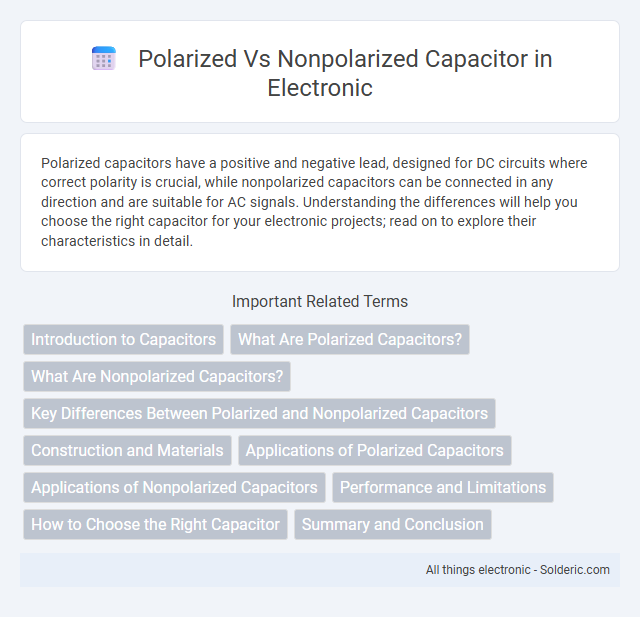Polarized capacitors have a positive and negative lead, designed for DC circuits where correct polarity is crucial, while nonpolarized capacitors can be connected in any direction and are suitable for AC signals. Understanding the differences will help you choose the right capacitor for your electronic projects; read on to explore their characteristics in detail.
Comparison Table
| Feature | Polarized Capacitor | Nonpolarized Capacitor |
|---|---|---|
| Polarity | Has positive and negative terminals | No polarity, can be connected either way |
| Typical Types | Electrolytic, Tantalum | Ceramic, Film, Mica |
| Voltage Rating | Usually lower voltage (< 100V) | Higher voltage ratings available |
| Capacitance Range | Higher capacitance (mF to mF) | Lower capacitance (pF to mF) |
| Applications | Power supply filtering, audio circuits | Tuning circuits, RF, signal coupling |
| Size | Larger size for given capacitance | Smaller size, stable |
| Reliability | Prone to polarity damage and leakage | More stable, less leakage |
Introduction to Capacitors
Capacitors store electrical energy by accumulating opposite charges on two conductive plates separated by an insulating material called the dielectric. Polarized capacitors, such as electrolytic capacitors, have a designated positive and negative terminal, making them suitable for DC circuit applications but unsuitable for AC circuits due to the risk of damage from reverse voltage. Nonpolarized capacitors, including ceramic and film capacitors, can operate with AC or DC signals, providing flexibility in filtering, coupling, and timing applications where polarity cannot be guaranteed.
What Are Polarized Capacitors?
Polarized capacitors, such as electrolytic and tantalum types, have distinct positive and negative terminals, requiring correct polarity for proper operation and to prevent damage. These capacitors typically offer higher capacitance values and are commonly used in power supply circuits and audio electronics. Their construction involves an electrolyte or oxide layer that enables large capacitance but limits their use in AC or reverse voltage environments.
What Are Nonpolarized Capacitors?
Nonpolarized capacitors are electronic components that can be connected in any direction within a circuit because they do not have a polarity, unlike polarized capacitors which have positive and negative leads. Common types of nonpolarized capacitors include ceramic, film, and mica capacitors, which are widely used in AC applications, signal processing, and timing circuits due to their stability and reliability. These capacitors are essential for applications requiring bidirectional current flow or AC voltage handling, as they do not suffer from polarity-related damage or performance issues.
Key Differences Between Polarized and Nonpolarized Capacitors
Polarized capacitors, such as electrolytic capacitors, have a defined positive and negative lead, making them suitable for DC circuits, whereas nonpolarized capacitors, like ceramic capacitors, can be connected in any orientation and are used primarily in AC applications. Polarized capacitors typically offer higher capacitance values and voltage ratings but require careful attention to polarity to avoid damage, while nonpolarized capacitors provide stability and reliability across a wider frequency range. Understanding these key differences helps you select the appropriate capacitor type based on circuit requirements and operating conditions.
Construction and Materials
Polarized capacitors typically consist of an electrolytic material as the dielectric, such as aluminum oxide or tantalum pentoxide, sandwiched between an anode and a liquid or solid electrolyte cathode, enabling high capacitance in a compact size. Nonpolarized capacitors are constructed using non-electrolytic dielectrics like ceramic, polyester, or mica, with metal film or foil electrodes, allowing them to function efficiently with AC signals and maintain polarity-independent operation. The materials and construction of polarized capacitors prioritize capacitance density, while nonpolarized capacitors emphasize stability and frequency response.
Applications of Polarized Capacitors
Polarized capacitors, such as electrolytic capacitors, are widely used in power supply filtering, audio equipment, and DC voltage smoothing due to their high capacitance and ability to handle large voltage loads. These capacitors are essential in circuits where polarity is maintained, providing stable energy storage and noise reduction. Your choice of a polarized capacitor is ideal for applications requiring efficient charge storage in low-frequency or DC scenarios.
Applications of Nonpolarized Capacitors
Nonpolarized capacitors are ideal for AC signal coupling and decoupling applications due to their ability to handle alternating currents without polarity restrictions. Their use in audio equipment, RF circuits, and timing devices ensures stable performance in environments requiring frequent polarity reversals. You can rely on nonpolarized capacitors for improved reliability in oscillators, filter networks, and sensor circuits where bidirectional current flow is crucial.
Performance and Limitations
Polarized capacitors, such as electrolytic capacitors, offer high capacitance values and are well-suited for DC applications but have limitations including polarity sensitivity, voltage rating constraints, and shorter lifespan under reverse voltage conditions. Nonpolarized capacitors, like ceramic or film types, perform reliably in AC circuits and exhibit better frequency response and stability but typically provide lower capacitance values and larger physical sizes for equivalent capacitance. Both capacitor types face trade-offs in leakage current, equivalent series resistance (ESR), and temperature sensitivity, influencing their performance in filtering, coupling, and timing applications.
How to Choose the Right Capacitor
Choosing the right capacitor depends on your circuit requirements, voltage polarity, and frequency. Polarized capacitors, such as electrolytic capacitors, are ideal for DC circuits with larger capacitance values but require correct polarity to avoid damage. Nonpolarized capacitors, like ceramic or film capacitors, provide stability in AC applications and are preferred when signal integrity and frequency response are critical for your design.
Summary and Conclusion
Polarized capacitors, such as electrolytic types, are designed for applications requiring higher capacitance and must be connected with correct polarity to prevent damage. Nonpolarized capacitors, including ceramic and film capacitors, offer more versatility in AC circuits and provide stable performance without polarity restrictions. Understanding the differences ensures you select the optimal capacitor for your electronic project's reliability and efficiency.
polarized vs nonpolarized capacitor Infographic

 solderic.com
solderic.com